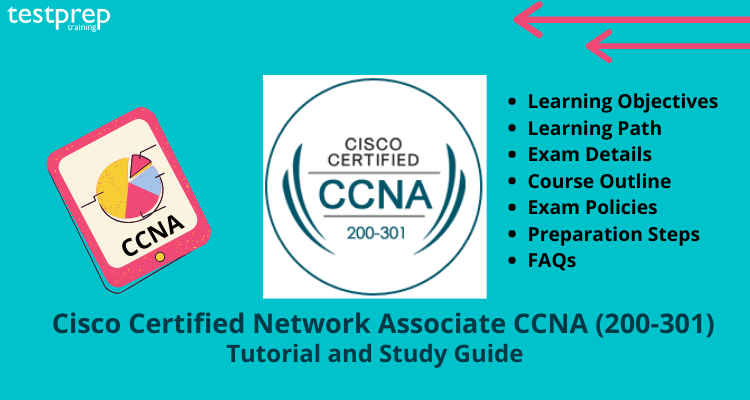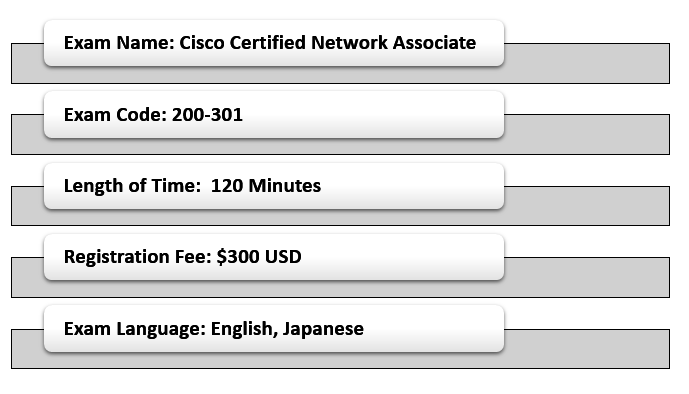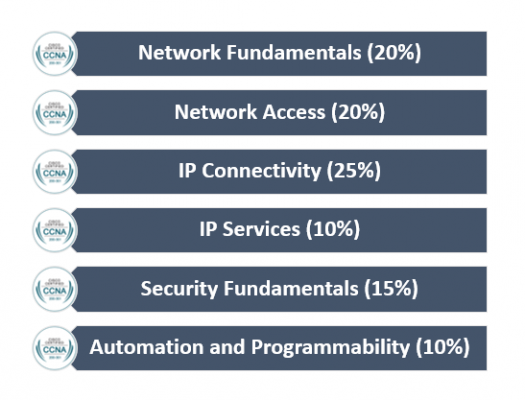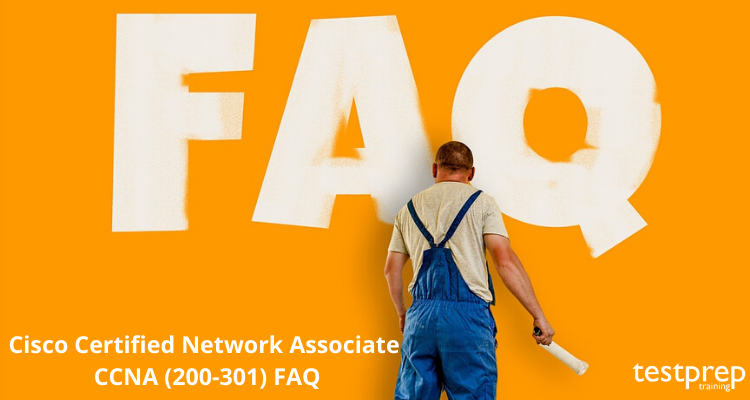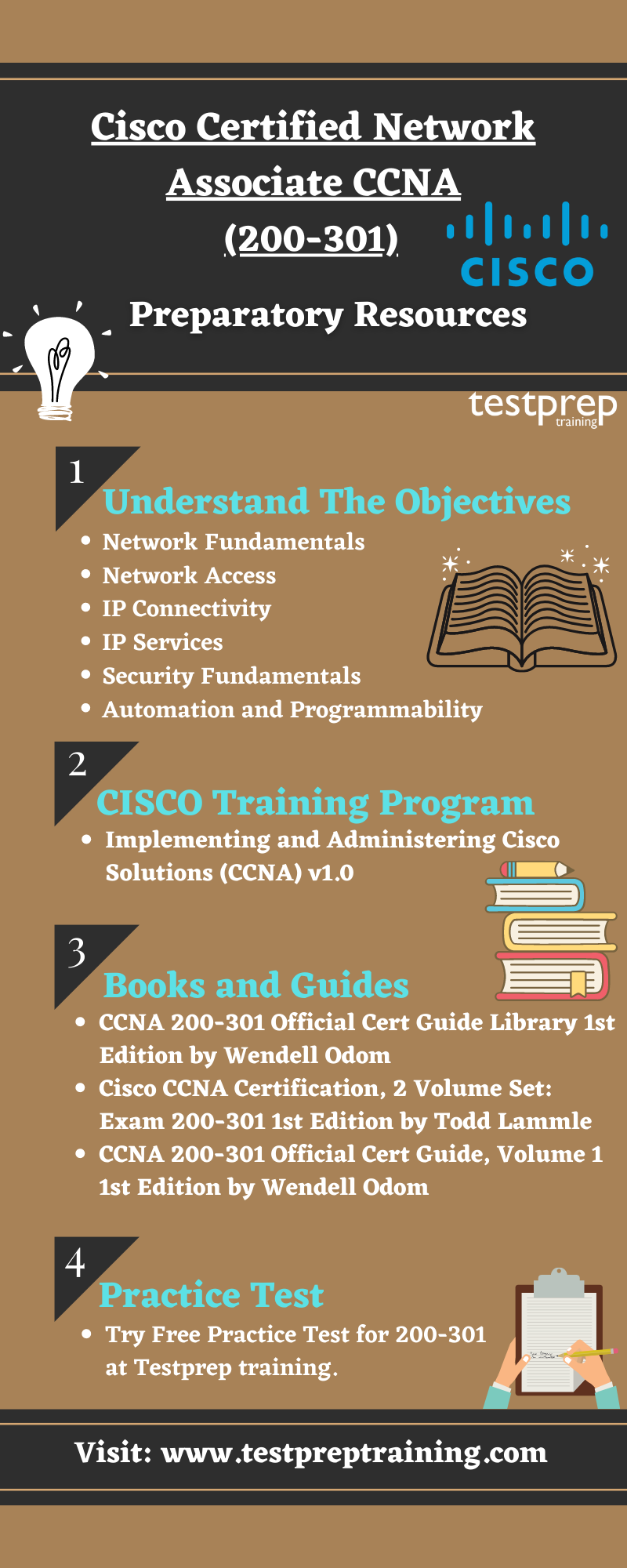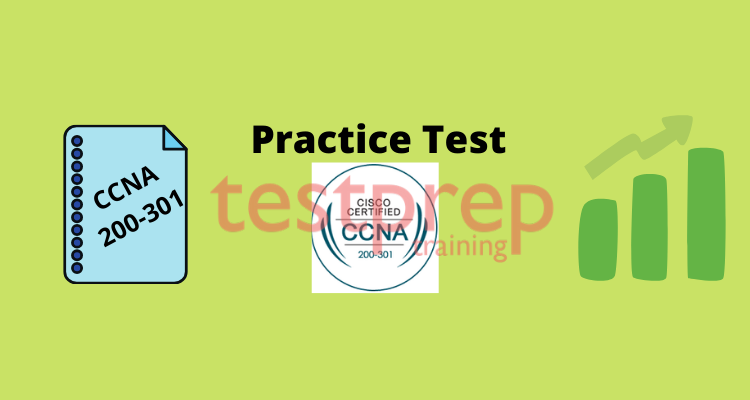Cisco Certified Network Associate CCNA (200-301)
Cisco Certified Network Associate CCNA (200-301) exam tests a candidate’s knowledge and skills associated with network fundamentals, IP connectivity, network access, IP services, security fundamentals, and automation and programmability. The exam also provides foundational knowledge for all support technicians involved in the basic installation, operation, and verification of Cisco networks.
The exam will help you get the role of:
- Entry-level network engineer
- Network administrator
- Network support technician
- Help desk technician

Who should take this exam?
- CCNA 200-301 students
- Current CCNA certified students that want to recertify
- Anyone starting a networking career and want to learn
Learning Objectives
The objectives for the Cisco Certified Network Associate CCNA (200-301) are:
- Domain 1: Network Fundamentals (20%)
- Domain 2: Network Access (20%)
- Domain 3: IP Connectivity (25%)
- Domain 4: IP Services (10%)
- Domain 5: Security Fundamentals (15%)
- Domain 6: Automation and Programmability (10%)
Learning Path
Cisco offers a number of certifications in various fields. There are many levels of certifications in Cisco such as entry, associate, specialist, professional, expert, architect. Each level incorporated many certifications in it.

Exam Details
The Cisco Certified Network Associate CCNA (200-301) exam is present in the English and Japanese language. The exam has a total of 120 questions. Further, the candidate can register their exam on the Pearson VUE and the examination fee is $300 USD.
Cisco Certified Network Associate CCNA (200-301) Course Outline
CISCO has divided the syllabus into various sections. The Cisco Certified Network Associate CCNA (200-301) exam includes its objectives and sub-topics in it. The detailed course outline is mentioned below:
Domain 1: Network Fundamentals (20%)
- Explain the role and function of network components
a Routers (CISCO Reference: Basic Router Configuration)
b L2 and L3 switches (CISCO Reference: Configuring Layer 2 Switching)
c Next-generation firewalls and IPS (CISCO Reference: Next-Generation Intrusion Prevention System (NGIPS))
d Access points
e Controllers (Cisco DNA Center and WLC) (CISCO Reference: Cisco DNA Center User Guide)
f Endpoints
g Servers
- Describe characteristics of network topology architectures
a 2 tier (CISCO Reference: Hierarchical Network Design)
b 3 tier
c Spine-leaf (CISCO Reference: Cisco Data Center Spine-and-Leaf Architecture)
d WAN (CISCO Reference: WAN (Wide-Area Network))
e Small office/home office (SOHO)
f On-premises and cloud
- Compare physical interface and cabling types
a Single-mode fiber, multimode fiber, copper (CISCO Reference: Cisco SFP Modules for Gigabit Ethernet Applications)
b Connections (Ethernet shared media and point-to-point)
c Concepts of PoE (CISCO Reference: Power over Ethernet (PoE))
- Identify interface and cable issues (collisions, errors, mismatch duplex, and/or speed) (CISCO Reference: Troubleshooting Ethernet Collisions)
- Compare TCP to UDP (CISCO Reference: Using TCP and UDP Services, UDP)
- Configure and verify IPv4 addressing and subnetting (CISCO Reference: IPv4 Addressing Configuration Guide)
- Describe the need for private IPv4 addressing (CISCO Reference: IP Addressing Guide)
- Configure and verify IPv6 addressing and prefix (CISCO Reference: IPv6 Addressing and Basic Connectivity Configuration Guide)
- Compare IPv6 address types
a Global unicast
b Unique local
c Link-local
d Anycast
e Multicast
f Modified EUI 64
(CISCO Reference: IPv6 Address Representation and Address Types)
- Verify IP parameters for Client OS (Windows, Mac OS, Linux)
- Describe wireless principles
a Nonoverlapping Wi-Fi channels
b SSID
c RF
d Encryption
(CISCO Reference: Wireless LAN Design Guide)
- Explain virtualization fundamentals (virtual machines)
- Describe switching concepts
a MAC learning and aging (CISCO Reference: Configuring MAC Learning)
b Frame switching (CISCO Reference: Configuring Switching Modes)
c Frame flooding
d MAC address table (CISCO Reference: Configuring the MAC Address Table)
Domain 2: Network Access (20%)
- Configure and verify VLANs (normal range) spanning multiple switches
a Access ports (data and voice) (CISCO Reference: Configuring Voice VLAN)
b Default VLAN (CISCO Reference: Configuring VLANs)
c Connectivity
- Configure and verify Interswitch connectivity
a Trunk ports (CISCO Reference: Configuring Access and Trunk Interfaces)
b 802.1Q (CISCO Reference: IEEE 802.1Q-in-Q VLAN Tag Termination)
c Native VLAN
- Configure and verify Layer 2 discovery protocols (Cisco Discovery Protocol and LLDP) (CISCO Reference: Cisco Discovery Protocol Version 2)
- Configure and verify (Layer 2/Layer 3) EtherChannel (LACP) (CISCO Reference: Configure and verify (Layer 2/Layer 3) EtherChannel (LACP))
- Describe the need for and basic operations of Rapid PVST+ Spanning Tree Protocol and identify basic operations
a Root port, root bridge (primary/secondary), and other port names
b Port states (forwarding/blocking) (CISCO Reference: Understanding Rapid Spanning Tree Protocol)
c PortFast benefits (CISCO Reference: Configuring Spanning Tree PortFast)
- Compare Cisco Wireless Architectures and AP modes (CISCO Reference: Cisco Unified Wireless Technology and Architecture)
- Describe physical infrastructure connections of WLAN components (AP, WLC, access/trunk ports, and LAG)
- Describe AP and WLC management access connections (Telnet, SSH, HTTP, HTTPS, console, and TACACS+/RADIUS) (CISCO Reference: Configure RADIUS and TACACS+ for GUI and CLI Authentication)
- Configure the components of a wireless LAN access for client connectivity using GUI only such as WLAN creation, security settings, QoS profiles, and advanced WLAN settings (CISCO Reference: Cisco Wireless LAN Controller Configuration Guide)
Domain 3: IP Connectivity (25%)
- Interpret the components of the routing table
(CISCO Reference: Route Selection in Cisco Routers)
a Routing protocol code
b Prefix
c Network mask
d Next hop
e Administrative distance (CISCO Reference: Administrative Distance)
f Metric
g Gateway of last resort (CISCO Reference: Configuring a Gateway of Last Resort Using IP Commands)
- Determine how a router makes a forwarding decision by default
a Longest match (CISCO Reference: Route Selection in Cisco Routers)
b Administrative distance (CISCO Reference: Administrative Distance)
c Routing protocol metric (CISCO Reference: Route Selection in Cisco Routers)
- Configure and verify IPv4 and IPv6 static routing
(CISCO Reference: IPv6 Routing: Static Routing)
a Default route (CISCO Reference: Configure Default-Route in EIGRP)
b Network route (CISCO Reference: Configuring Static Routing)
c Host route
d Floating static
- Configure and verify single area OSPFv2
a Neighbor adjacencies (CISCO Reference: OSPF Neighbor Problems)
b Point-to-point
c Broadcast (DR/BDR selection) (CISCO Reference: OSPF Neighbor States)
d Router ID
- Describe the purpose of first-hop redundancy protocol (CISCO Reference: First Hop Redundancy Protocols Configuration Guide)
Domain 4: IP Services (10%)
- Configure and verify inside source NAT using static and pools 2019 Cisco Systems, Inc. (CISCO Reference: Configuring NAT for IP Address Conservation)
- Configure and verify NTP operating in a client and server mode (CISCO Reference: Configuring NTP)
- Explain the role of DHCP and DNS within the network (CISCO Reference: Configuring the Cisco IOS DHCP Server)
- Explain the function of SNMP in network operations (CISCO Reference: SNMP)
- Describe the use of Syslog features including facilities and levels (CISCO Reference: System Message Logging)
- Configure and verify DHCP client and relay (CISCO Reference: Configuring the Cisco IOS DHCP Relay Agent, Configuring the Cisco IOS DHCP Relay Agent)
- Explain the forwarding per-hop behavior (PHB) for QoS such as classification, marking, queuing, congestion, policing, shaping (CISCO Reference: Overview of DiffServ for Quality of Service)
- Configure network devices for remote access using SSH
- Describe the capabilities and function of TFTP/FTP in the network
Domain 5: Security Fundamentals (15%)
- Define key security concepts (threats, vulnerabilities, exploits, and mitigation techniques)
- Describe security program elements (user awareness, training, and physical access control) (CISCO Reference: Network Security Concepts and Policies)
- Configure device access control using local passwords (CISCO Reference: Configuring Local Authentication, Multi-factor Authentication, and Password Security)
- Describe security password policies elements, such as management, complexity, and password alternatives (multifactor authentication, certificates, and biometrics) (CISCO Reference: Multifactor authentication methods)
- Describe remote access and site-to-site VPNs (CISCO Reference: Managing Site-to-Site VPNs)
- Configure and verify access control lists (CISCO Reference: Configuring IP Access Lists)
- Configure Layer 2 security features (DHCP snooping, dynamic ARP inspection, and port security) (CISCO Reference: Understanding and Configuring Dynamic ARP Inspection)
- Differentiate authentication, authorization, and accounting concepts (CISCO Reference: Configuring Accounting)
- Describe wireless security protocols (WPA, WPA2, and WPA3)
- Configure WLAN using WPA2 PSK using the GUI (CISCO Reference: WPA2-PSK and Open Authentication with Cisco 5760 WLC Configuration)
Domain 6: Automation and Programmability (10%)
- Explain how automation impacts network management (CISCO Reference: Network Management System, Network Automation)
- Compare traditional networks with controller-based networking (CISCO Reference: Introduction to Controller-Based Networking)
- Describe controller-based and software-defined architectures (overlay, underlay, and fabric)
CISCO Reference: Software-Defined Networking
a Separation of control plane and data plane Control Plane and User Plane Separation (CUPS)
b North-bound and south-bound APIs
- Compare traditional campus device management with Cisco DNA Center enabled device management (CISCO Reference: Software-Defined Access & Cisco DNA Center Management)
- Describe the characteristics of REST-based APIs (CRUD, HTTP verbs, and data encoding) (CISCO Reference: Using the REST API)
- Recognize the capabilities of configuration management mechanisms Puppet, Chef, and Ansible
- Interpret JSON encoded data
Certification Exam Policies
The candidate should visit the CISCO official website for understanding the terms and policies of the CISCO. The exam terms and policies include various important information such as age requirements and policies concerning minors, candidate identification and authentication, rights and responsibilities, Confidentiality and agreements, etc.
Cisco Certified Network Associate CCNA (200-301) FAQ
Cisco Certified Network Associate CCNA (200-301) Preparation Steps
The preparation steps which are essential in order to successfully pass the Cisco Certified Network Associate CCNA (200-301) exam are:
CISCO Official Website
Visiting the CISCO official website is an important step while preparing for the Cisco Certified Network Associate CCNA (200-301) exam. The official site offers a lot of reliable information and sources which are very helpful in preparing for the exam. The resources such as study guide, sample papers, whitepapers, documentation, faqs, etc. The candidate can find all such important things on the official page.
CISCO Training Program
Training programs are a very necessary step in the preparation of such exams like Cisco Certified Network Associate CCNA (200-301). CISCO offers its own training programs on their various examinations and certifications. For the Cisco Certified Network Associate CCNA (200-301) exam, it offers:
Implementing and Administering Cisco Solutions (CCNA) v1.0
This course will help you:
- Learn the knowledge and skills to install, configure, and operate a small- to medium-sized network
- Gain a foundation in the essentials of networking, security, and automation
- Prepare for the 200-301 CCNA exam, which earns CCNA certification.
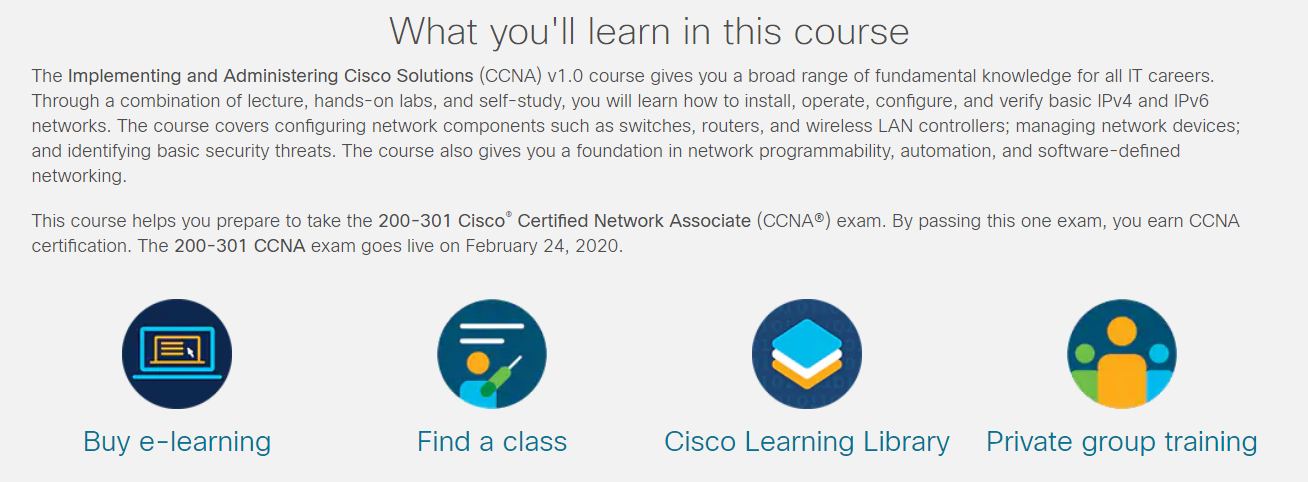
Books and Guides 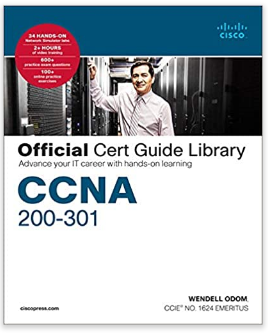
The next step in the preparatory guide should be books and study guides. The candidate needs to find those books which are enriched with information. Finding a good book may be a difficult task, but in order to gather the knowledge and skills, the candidate has to find, read and understand. We recommend the followings:
- CCNA 200-301 Official Cert Guide Library 1st Edition by Wendell Odom
- Cisco CCNA Certification, 2 Volume Set: Exam 200-301 1st Edition by Todd Lammle
- CCNA 200-301 Official Cert Guide, Volume 1 1st Edition by Wendell Odom
- 31 Days Before Your CCNA Exam: A Day-By-Day Review Guide for the CCNA 200-301 Certification Exam 1st Edition by Allan Johnson
Practice Test
Most importantly, candidates have to try their hands-on practice tests. Practice tests are the one who secures the candidate about their preparation. The practice test will help the candidates to recognise their vulnerable areas so that they can work on them. There are many practice tests available on the internet nowadays, so the candidate can choose which they want.
Join a Study Group
Joining a group study will also be beneficial for the candidate. It will encourage them to do more hard work. Also, studying in the group will help them to stay connected with the other people who are on the same pathway as them. Also, the discussion of such study groups will benefit the students in their exam.

